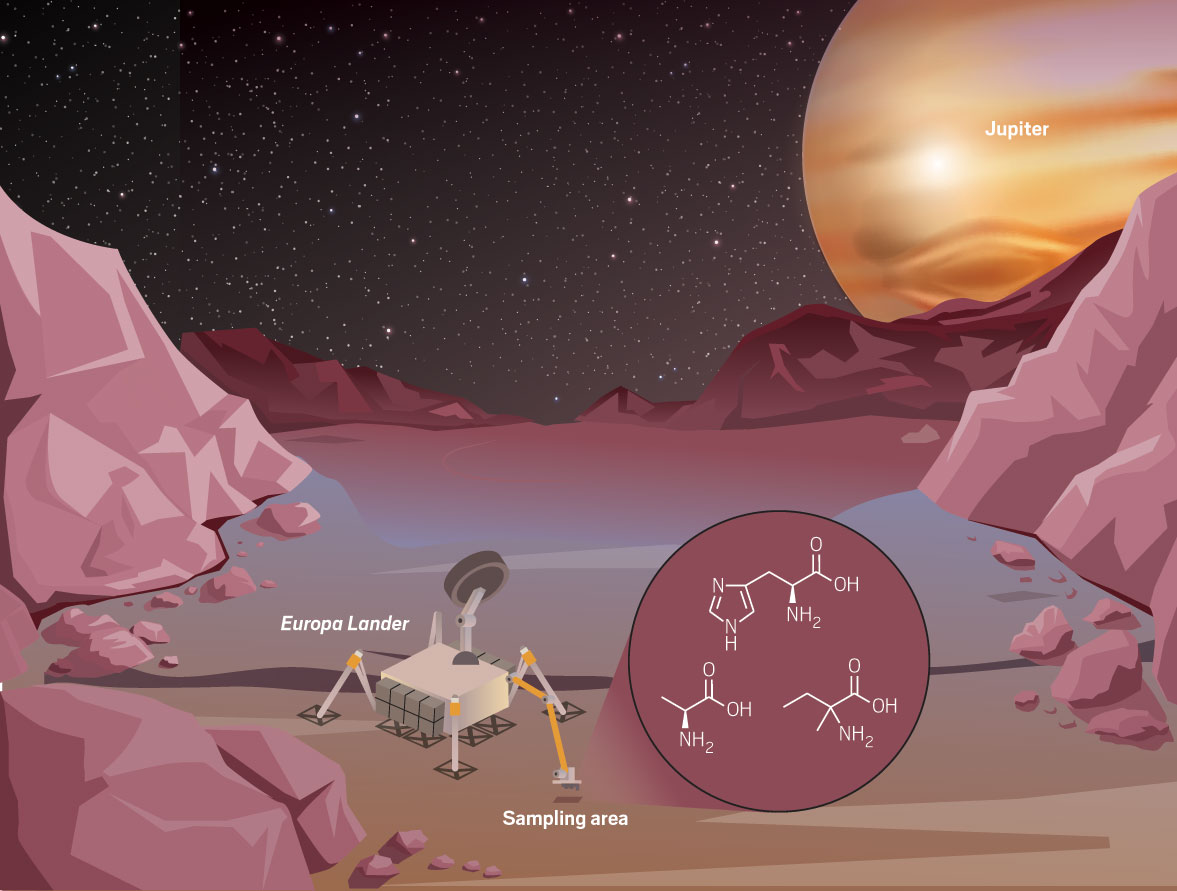Advertisement
Grab your lab coat. Let's get started
Welcome!
Welcome!
Create an account below to get 6 C&EN articles per month, receive newsletters and more - all free.
It seems this is your first time logging in online. Please enter the following information to continue.
As an ACS member you automatically get access to this site. All we need is few more details to create your reading experience.
Not you? Sign in with a different account.
Not you? Sign in with a different account.
ERROR 1
ERROR 1
ERROR 2
ERROR 2
ERROR 2
ERROR 2
ERROR 2
Password and Confirm password must match.
If you have an ACS member number, please enter it here so we can link this account to your membership. (optional)
ERROR 2
ACS values your privacy. By submitting your information, you are gaining access to C&EN and subscribing to our weekly newsletter. We use the information you provide to make your reading experience better, and we will never sell your data to third party members.

Morgan Cable
Stargazing scientist is exploring exotic chemistry on other worlds
by Bethany Halford
August 20, 2018 | APPEARED IN VOLUME 96, ISSUE 33
Because Morgan Cable grew up in the shadow of Florida's Kennedy Space Center, space science was never far from her imagination. "Our elementary school would schedule fire drills to coincide with launches," she remembers. She and her classmates would file outside amid the wailing alarms just in time to see a rocket take flight in a fiery blaze. Although she didn't know it then, Cable would one day be planning the precious scientific cargo for those rockets.
As a research scientist at the Jet Propulsion Laboratory (JPL), Cable spends part of her time doing chemistry experiments that mimic the conditions on Saturn's moon Titan, which has lakes of liquid methane and ethane, as well as a nitrogen-rich atmosphere.
"I'm interested in trying to understand what kinds of physical and chemical processes can happen on a world like this," Cable says. She's learned that even though Titan's a chilly –183 °C, there's still plenty of interesting chemistry going on. By simulating the conditions on Titan in the lab, Cable has found that benzene-ethane and acetylene-ammonia co-crystals may be forming on the satellite's surface.
"Morgan makes the Energizer Bunny look like a slowpoke," says Harry Gray, a California Institute of Technology chemistry professor and one of Cable's doctoral advisers. "I'm sure her work will soon reveal exotic reactions occurring in the methane seas of Titan."
The other part of Cable's job is to figure out which instruments will visit Jupiter's moon Europa as part of NASA's proposed Europa Lander mission—with the aim of possibly detecting life on the icy surface that covers that moon's ocean of water.
"Morgan is truly a rare combination of explorer chemist and great public communicator," says Adrian Ponce, a JPL scientist who also supervised Cable's doctoral work. At NASA, he says, Cable is recognized as an expert on the chemistry and spectroscopy of Titan, Europa, and Enceladus, another of Saturn's moons. "I am sure many great discoveries will ensue as her career at NASA advances, and I can easily imagine her becoming as recognizable in the public eye as the likes of Carl Sagan."
Vitals
Current affiliation: NASA Jet Propulsion Laboratory
Age: 35
Ph.D. alma mater: Caltech
Role model: My role model is my father, who was also a Ph.D. chemist. He encouraged me at an early age to do science projects and design experiments myself to answer my questions about the world around me. He passed away a couple of years ago, and I think about him every single day.
Hobby: Mountain unicycling. It's the one thing I've found where I have to be completely, 100% focused on what I'm doing. It's sort of like meditation in motion for me.
Latest TV show binge-watched: "Dark Matter"
Walk-up song: "Spotlight" by Mutemath
Research at a glance

Credit: Yang H. Ku/C&EN/Shutterstock
Cable is an expert at detecting chemistry on astronomical bodies like Jupiter's moon Europa. If the Europa Lander gets NASA's nod to launch, she will plan the instruments the probe will use to find amino acids, which could be signs of life.
Three key papers
"Prospects for Mineralogy on Titan"
(Am. Mineral. 2018, DOI: 10.2138/am-2018-6259)
"Enhancement of Anion Binding in Lanthanide Optical Sensors"
(Acc. Chem. Res. 2013, DOI: 10.1021/ar400050t)
Astrochemistry
Morgan Cable
Stargazing scientist is exploring exotic chemistry on other worlds
by Bethany Halford
August 19, 2018
| A version of this story appeared in
Volume 96, Issue 33


Vitals
Current affiliation: NASA Jet Propulsion Laboratory
Age: 35
Ph.D. alma mater: Caltech
Role model: My role model is my father, who was also a Ph.D. chemist. He encouraged me at an early age to do science projects and design experiments myself to answer my questions about the world around me. He passed away a couple of years ago, and I think about him every single day.
Hobby: Mountain unicycling. It’s the one thing I’ve found where I have to be completely, 100% focused on what I’m doing. It’s sort of like meditation in motion for me.
Latest TV show binge-watched: “Dark Matter”
Walk-up song: “Spotlight” by Mutemath
Three key papers
“Prospects for Mineralogy on Titan” (Am. Mineral. 2018, DOI: 10.2138/am-2018-6259)
“Enhancement of Anion Binding in Lanthanide Optical Sensors” (Acc. Chem. Res.2013, DOI: 10.1021/ar400050t)
“Titan Tholins: Simulating Titan Organic Chemistry in the Cassini-Huygens Era” (Chem. Rev. 2011, DOI: 10.1021/cr200221x)
Because Morgan Cable grew up in the shadow of Florida’s Kennedy Space Center, space science was never far from her imagination. “Our elementary school would schedule fire drills to coincide with launches,” she remembers. She and her classmates would file outside amid the wailing alarms just in time to see a rocket take flight in a fiery blaze. Although she didn’t know it then, Cable would one day be planning the precious scientific cargo for those rockets.
As a research scientist at the NASA Jet Propulsion Laboratory (JPL), Cable spends part of her time doing chemistry experiments that mimic the conditions on Saturn’s moon Titan, which has lakes of liquid methane and ethane, as well as a nitrogen-rich atmosphere.
“I’m interested in trying to understand what kinds of physical and chemical processes can happen on a world like this,” Cable says. She’s learned that even though Titan’s a chilly –183 °C, there’s still plenty of interesting chemistry going on. By simulating the conditions on Titan in the lab, Cable has found that benzene-ethane and acetylene-ammonia cocrystals may be forming on the satellite’s surface.
“Morgan makes the Energizer Bunny look like a slowpoke,” says Harry Gray, a California Institute of Technology chemistry professor and one of Cable’s doctoral advisers. “I’m sure her work will soon reveal exotic reactions occurring in the methane seas of Titan.”
The other part of Cable’s job is to figure out which instruments will visit Jupiter’s moon Europa as part of NASA’s proposed Europa lander mission—with the aim of possibly detecting life on the icy surface that covers that moon’s ocean of water.
“Morgan is truly a rare combination of explorer chemist and great public communicator,” says Adrian Ponce, a JPL scientist who also supervised Cable’s doctoral work. At NASA, he says, Cable is recognized as an expert on the chemistry and spectroscopy of Titan, Europa, and Enceladus, another of Saturn’s moons. “I am sure many great discoveries will ensue as her career at NASA advances, and I can easily imagine her becoming as recognizable in the public eye as the likes of Carl Sagan.”

















Join the conversation
Contact the reporter
Submit a Letter to the Editor for publication
Engage with us on Twitter